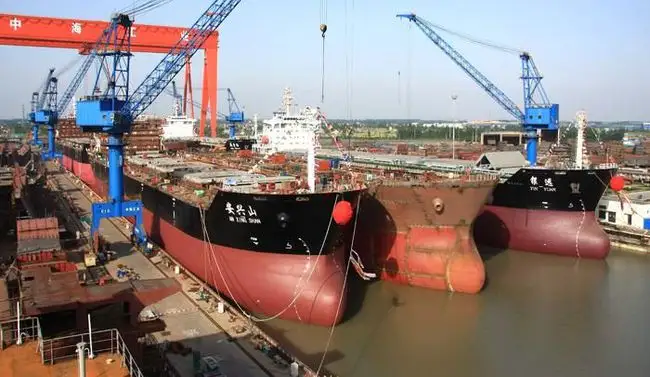Shipbuilding industry upturn cycle may have arrived.
Data released by Clarkson, a British shipbuilding and shipping industry analyst, on September 6 showed that in August, the global new ship orders were 1.88 million revised gross tons (51 ships), of which, China topped the list with 1.02 million revised gross tons (54%); South Korea ranked second with 760,000 revised gross tons (41%). As of the end of August, the global order book on hand was 102.76 million revised gross tons, with China leading with 43.62 million revised gross tons (42%) and South Korea ranking second with 35.97 million revised gross tons (35%).
"Ship prices rose for 21 months in a row, it is basically certain that the shipbuilding industry has reached the upward cycle, and now the major domestic shipbuilders orders enough, although the number or less than last year, but the individual order profits rose significantly." Deppon securities machinery industry chief analyst Ni Zhengyang said in an exclusive interview with the "securities daily" reporter.

Ship prices rose for 21 consecutive months
The industry is expected to shipbuilding big cycle coming
Clarkson number shows, from January to August this year, the global cumulative new ship orders for 27.68 million revised gross tons, down 30% year-on-year. China and South Korea took 12.35 million revised gross tons (475 ships) and 11.92 million revised gross tons (216 ships) respectively, accounting for 45% and 43% of the share each.
From a worldwide perspective, new ship orders have exploded.
The global newbuilding order book has increased from 1,058 vessels of 75 million dwt in 2020 to 1,765 vessels of 132 million dwt in 2021, the second highest in the past 10 years. the momentum of strong newbuilding demand has continued since 2022.
Price is the best vane of supply and demand. Entering August this year, the Clarkson Newbuilding Price Index exceeded 160 points, the highest level since March 2009, as ship prices soared.
"The industry has ushered in a new round of major cycles. Review the history of shipbuilding development, each century can be divided into four cycles, each cycle is about 20 years to 30 years between, this round of ship prices have risen for 21 months in a row." Ni Zhengyang to the "securities daily" reporter said so.
In addition to the ship price rise, ship space tension is also one of the performance of the coming of the upward cycle. Clarkson said, the current Chinese shipyard handheld orders are full, most of the major shipyards ship space scheduled to early 2025.
"In the first half of the year, the company's handheld orders 239 ships / 20,755,000 dwt, the current order is full, the order schedule has been to 2026." An insider of a listed company in the shipbuilding industry added to the "Securities Daily" reporter.
In addition, orders for high value-added vessels represented by LNG vessels have increased greatly, and geopolitical conflicts have exacerbated the tension and volatility of the global gas market, with new orders for LNG vessels reaching 98 in 2021, up 81% from 54 in 2020. This compares to 108 vessels in the first half of 2022 alone.
Vessel volume and price rise
Upside cycle may have just started

"According to historical data statistics, 1960 to 1973 and 1990 to 2010 are the previous two rounds of shipbuilding industry upward cycle, the average interval of 20 to 30 years to experience a round, the reason is that the demand cycle, ship age replacement cycle, environmental protection conventions three major factors." The above-mentioned shipbuilding industry listed company insiders said to the "Securities Daily" reporter.
From the demand side, the current round of shipbuilding industry upward cycle of container ships to take the lead.
Starting in the third quarter of 2020, China's export container freight index (CCFI) began to show a sharp pull up, which in turn led to a rapid rise in new ship orders (576 new container ship orders in 2021 and only 122 new orders in 2020), and the new ship price index also began to move higher at the end of 2020.
"After the epidemic, global logistics supply is poor and major ports are congested leading to a sharp upward movement in shipping prices, and the global ship operation efficiency is reduced, driving the demand for new ship orders upward. In addition, the shipowners' profit repair, the willingness to upgrade the purchase of new ships has pushed the order growth, which is now in the phase of volume and price increase." Ni Zhengyang told the "Securities Daily" reporter.
"In the context of energy transformation, LNG ship demand is also being released one after another, optimistic about the growth of subsequent bulk carrier, oil tanker and LNG ship orders. In addition, the EEXI and CII standards that will come into effect in 2023 will accelerate the progress of shipowners to change ships, and the current round of shipbuilding industry upside cycle has just started." Ni Zhengyang said.

